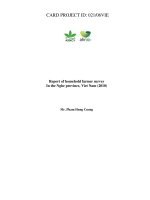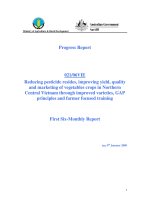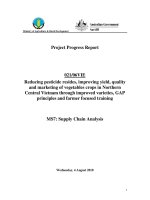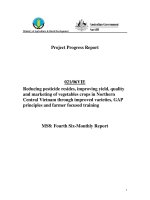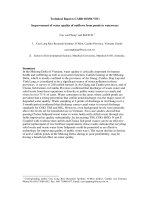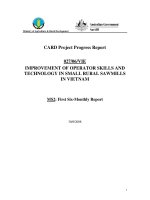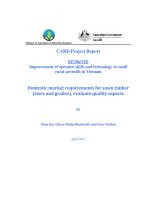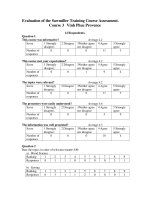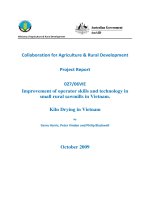Báo cáo khoa học nông nghiệp " Improvement of operator skills and technology in small rural sawmills in Vietnam. " doc
Bạn đang xem bản rút gọn của tài liệu. Xem và tải ngay bản đầy đủ của tài liệu tại đây (6.13 MB, 79 trang )
Ministry of Agriculture & Rural Development
Collaboration for Agriculture & Rural Development
Project Report
027/06VIE
Improvement of operator skills and technology in
small rural sawmills in Vietnam.
Kiln Drying in V
ietnam
by
Gerry Harris, Peter Vinden and Philip Blackwell
October 2009
Project Report
027/06VIE
Improvement of operator skills and technology in small rural sawmills in Viet
n
am.
Kiln Drying in Vietnam
Page
2
of
79
INDEX
INDEX
2
PART 1
-
VIETNAM FACTORY VISI
TS AND KILN ASSES
SMENT
5
Introduction
5
Background
5
Summary of results
.
6
Temperature Monitoring & Controls
9
Air Flow
12
Baffling
12
Racking Practises
17
Findings
18
Wood fired Boilers
19
APPENDIX
-
FACTORY VISIT REPORT
S
21
Factory Visits A
-
CAXE Environmental & Thermal Engineering Co Ltd
21
Director Mr Bui Anh Viet
21
Factory Visits B
-
Hoang Thanh Company
23
Factory Visits C
-
Troung Tai Compa
ny
28
Factory Visits D
-
CHANH HUNG DRYING UNIT
30
Factory Visits E
-
Nong Lam University
37
Factory Visits F
-
Thien Hung Company Technologies (THC)
42
THC Factory
43
THC Kilns
44
Factory Visits G
-
Forest Science Institute of Vietnam
–
Sth. Vietnam Co
-
Op
50
Factory Visits H
-
Truong Thanh Wood Processing
57
PART 2
POTENTIAL FOR SOLAR
KILNS IN VIETNAM
65
Introduction
65
Backgroun
d
65
The efficiency of solar drying
68
Climatic Data
70
Calculat
ion Method for Fuel Savings
70
Insolation
71
Kiln types
73
Concl
usions
78
REFERENCES
79
Project Report
027/06VIE
Improvement of operator skills and technology in small rural sawmills in Viet
n
am.
Kiln Drying in Vietnam
Page
3
of
79
SUMMARY AND RECOMMENDATIONS
This report is in two parts. Part 1 summarises a number of visits to furniture
manufacturers and sawmills w
here audits were undertaken of the operation of the
kilns. The kilns varied in sophistication from being state of the art t
echnology to low
cost, low tech, locally built plant. However,
without exception improvements could be
mad
e to the operation of each
kiln that was audited. This
report summarises where
improvements can be made to each of the kilns
visited. T
his
form
s
the basis of a
“Wood drying improvement program”
that needs to be implemented
. This is an
urgent need given that most of the kiln dried ma
terial is destined for furniture
manufacture. As a general comment most kilns
in
Vietnam operate
as
ovens. Whilst
the primary objective of reducing the moisture content
of timber
to below fibre
saturation point
(28%moisture content
) is
achieved, there is a
high variability in final
moisture content. This inevitably results
in down
-
stream problems associated with
the quality of joinery or furniture that is manufactured
from the timber
.
Part 2 evaluates the potential for solar kiln drying in Vietnam.
There i
s great
potential for solar kiln drying technology in Vietnam for furniture manufacturers and
small sawmillers particularly in the HCM City region and Dak Lak Province, where
air
-
drying is prevalent and where final drying of timber to equilibrium moisture
content is a requirement of further processing.
It is recommended that:
1.
A “Wood drying improvement program” is established by the Department of
Forestry comprising customised advice and generic training on site at each
processing facility where drying is
undertaken. Some nominal charge should
be made for the provision of this service. It is antici
pated that the service
would take approximately 1week and could involve
2.
Further research is needed to develop drying and processing methodologies
specifically f
or plantation grown acacias for use in furniture production in
Vietnam.
This could involve the training of a Masters research student jointly
in Vietnam and Australia, with the objective of training the person for
implementing the “Wood drying improvement
program”.
3.
The development of new d
rying technology should focus on:
Solar kilns
using Australian technology
in the first instance,
to develop
demonstration models for solar drying in Vietnam
. This could be
followed up by local manufacture.
Comparative inv
estigations are needed to determine the best locations
for solar drying (using the regression analysis models identified in this
report) throughout Vietnam.
4.
A model should be developed for the creation of modern drying plants for
clusters of small
-
scale sa
wmills and/or clustering existing sawmills into larger
Project Report
027/06VIE
Improvement of operator skills and technology in small rural sawmills in Viet
n
am.
Kiln Drying in Vietnam
Page
4
of
79
units to improve processing and drying techniques. Funding is needed to
support the building of appropriate kilns.
Project Report
027/06VIE
Improvement of operator skills and technology in small rural sawmills in Viet
n
am.
Kiln Drying in Vietnam
Page
5
of
79
PART 1
-
VIETNAM FACTORY VISI
TS AND KILN ASSESSME
NT
Introduction
The CARD Team visite
d a number of furniture factories located in the Central and
South Vietnam, with kiln drying facilities. The facilities at these factories ranged from
very basic, small capacity, in
-
house built kilns to very large capacity modern units.
The Team also visit
ed a number of kiln manufactures in order to gain an
understanding of the expertise in Vietnam.
All kilns assessed by the Team utilised wood waste as the main heat source, either
as direct fire units, suppling heat to the kiln chamber via flue gasses duct
ed through
the kiln or as a fuel supply to boilers which inturn supply heat to the kiln via heat
exchangers in the form of steam.
The Team also inspected the drying facilities at Nong Lam University which had
research and commercial drying facilities. Thes
e facilities were originally established
and designed by Prof. Cac in the 1990’s (see CAXE Section in appendix A for further
description). This design appeared to be the basis of many of the kilns assessed by
the Team throughout Vietnam.
Background
The pro
cess of timber or ‘lumber’ drying, also know as ‘timber seasoning’ and is the
process of removing water from the timber to a target moisture content (TMC) suited
to the purpose of use. The moisture content (MC) of timber in service is usually in
the range
of 8
-
15%.
In freshly felled green logs the wood cell walls and the inside the cell (i.e. lumen) are
fully saturated with water. When drying starts the water inside the lumen is lost first,
then the water from the cell wall starts to is evaporate
(Bootle, 2005)
. This process
will continue (over time) until eventually it reaches a moisture content that is in
equilibrium with the surrounding environment. The point at which there is only
moisture
left in the cell walls is referred to as the ‘fibre saturation point’ (fsp)
Timber is dried mainly:
To reduce its weight for the purpose of transport,
To increase strength
–
dry wood is considerably stronger than green wood,
To produce a product that is s
table and durable and
That can be painted / stained and glued and
Can be machined and finished to an acceptable standard
(ATSM, 1997)
.
From a commerc
ial perspective this needs to be done as cheaply and efficiently as
possible and to achieve this goal the timber needs to dried as fast as possible
without too much degrade
(Wa
lker, 2006)
. The purpose of drying timber (from a
commercial perspective) is to:
Dry the stack of timber as fast as possible
–
without excessive degrade
Project Report
027/06VIE
Improvement of operator skills and technology in small rural sawmills in Viet
n
am.
Kiln Drying in Vietnam
Page
6
of
79
Dry to the desired MC and within set limits (e.g. ± 2% MC)
Produce timber that is relatively free of i
nternal stress, e.g. relieve drying
stresses by conditioning at the end of the schedule
Produce timber that is relatively free of degrade e.g. checks, collapse and
stains
(Walk
er, 2006)
.
Therefore from a value adding point of view it is essential that the drying practice is a
controlled and continually monitored process to ensure the highest value can be
obtain from the timber being produced.
Summary of results
The Team found t
hat there was a general lack of understanding of the basic
principles of drying lumber by the workers and kiln operators. Kiln operators often
used the rear of the kiln as a place of residence. Kiln condition appeared to be
controlled on a set and forget b
asis.
In particular there appeared to be a lack of understanding, by the operators, as
regards the relationship between dry bulb (DB) and wet bulb (WB) temperatures,
airflow and timber racking and the overall effect that these parameters have on the
condi
tions inside the kiln and the resultant non
-
uniformity of drying of the lumber if
they are not correctly monitored and controlled.
More specifically it was often found that WB sensors were disconnected (possibly by
the operators) from the kilns control sys
tem (fig. 1). This meant that the kilns were
solely controlled on DB temperature alone, in effect creating a ‘hot box’, with no
humidity control. The operators appeared to have made this decision to control the
kilns only by DB temperature, purely to simpl
ify the process through lack of
understanding of the actual relationship between DB and WB temperatures. It was
reported at one facility that as they had dried using the same schedule (i.e. using DB
and WB temperatures) that the operator knew from past exp
erience when to change
condition based on the DB temperature alone.
Where sensors were correctly installed they were only used for manual control, that
is, the control of kiln conditions relied basically on the operator monitoring the
temperature (i.e. WB
and/or DB) and making a ‘uneducated’ decision to open or
close the appropriate valve or vent, which was set and forgot until next time he
happened to check the reading.
Humidity control was generally based on a random basis depending on the gut
feeling of
the operator. It was reported at one facility that the humidity control
consisted of “turning the stop valve, mounted on the external wall, ‘ON’ until water
ran out from under the door”.
Only one kiln drying facility had fully automated controls ensuring 2
4 hour control of
the drying conditions inside the kiln.
Project Report
027/06VIE
Improvement of operator skills and technology in small rural sawmills in Viet
n
am.
Kiln Drying in Vietnam
Page
7
of
79
The use of baffling to restrict by
-
passing around stacks was nonexistent. Also it was
observed on one occasion that boards were rotated 90° to the airflow in order to
stack more material inside the k
iln (fig. 4a) in order to fill up the remaining space
inside the kiln which did not allow for a full length board. This had the effect of
blocking any cross flow between the boards due to the placement of stickers at
regular intervals.
Further it was obser
ved that kilns were generally stacked to ‘maximum capacity’ with
little regard to leaving sufficient ‘plenum’ space between the edge of the stack and
the side of the kiln wall (fig.4b). This has the effect of creating uneven airflow through
the stack, from
top to bottom. On some occasions the plenum space was filled up
with surplus material that required redrying (fig. 4c). This practise only leads to
reduced efficiency of the kiln.
With respect to timber stacking it was found that there was a lack of use o
f dedicated
material for ‘stickers’. In general boards were racked out using the same material
that was being dried, by placing the components or boards at right angles in a
‘crosshatched’ fashion (fig. 4d) to create the gap between boards in order to allo
w
airflow. This meant that often the gap was too wide, consequentially reducing the
efficiency of the kiln.
Figure 1. Disconnected wet bulb sensor.
Figure 2. Typical kiln controls
–
DB sensors and fan switches
Project Report
027/06VIE
Improvement of operator skills and technology in small rural sawmills in Viet
n
am.
Kiln Drying in Vietnam
Page
8
of
79
Figure 3. Analogue readout inserted t
hrough wall.
Figure 4a. Boards stacked at right angles to airflow.
Figure 4b. Minimum plenum space.
Figure 4c. Excess components stacked in plenum space.
Project Report
027/06VIE
Improvement of operator skills and technology in small rural sawmills in Viet
n
am.
Kiln Drying in Vietnam
Page
9
of
79
Figure 4d. Typical example of ‘crosshatch’ stacking.
Temperature Monitoring &
Controls
The
drying conditions inside a kiln are, in general, monitored by the measurement of
the dry bulb temperature (DBT) and wet bulb temperature (WBT). These parameters
can in turn be used to determine the relative humidity (RH) (i.e. the amount of
moisture in th
e air). These three (3) parameters can be used to determine the
equilibrium moisture content (EMC) or the dry effort of the environment inside the
kiln. DBT and WBT are set according to predetermined conditions which are known
as ‘schedules’ or recipes. Di
fferent schedules are used for specific species and are
determined through extensive research and consultation with industry. And example
specific schedule maybe DBT = 60° and WBT = 55° giving and EMC = 12.5%. If the
kiln is controlled only on DBT (i.e. no
humidity control) may result in the EMC falling
as low as 2
-
3%, generating an extremely harsh and dry environment which may lead
to drying degrade in the product.
The practise of drying lumber, monitoring only the DBT is not recommended as it
questionable
as to whether the practice will result in acceptable drying quality,
especially for high valued products such as fro furniture. This practice can only lead
to moisture content variations in the final product and contribute to drying stress and
degrade. Th
is is due to the potentially low EMC’s that may be maintained in the
drying chamber, resulting from the lack of humidity. In high value product such as in
furniture where components are require to be laminated into larger components, it is
essential to hav
e uniform moisture content, both within and between components.
Any variation in MC (between pieces or boards) will result in uneven shrinkage,
resulting in defects such as splitting or cracking in the finished product. Further if the
boards are ripped or
machined, the inherent drying stresses will result in
unacceptable distortion in the finished product.
The Team found that WB sensors were not used and they had been deliberately
disconnected (fig. 1). This meant that the kilns were solely controlled on DB
temperature alone, in effect creating a ‘hot box’, with no humidity control. The
majority of sensors that were correctly installed were only of a ‘manual’ control type
Project Report
027/06VIE
Improvement of operator skills and technology in small rural sawmills in Viet
n
am.
Kiln Drying in Vietnam
Page
10
of
79
comprising of and analogue readout with a stem that was inserted through the
external w
all (fig 3). This would have the effect of conducting heat away from the
sensing element and through the opening in the wall, giving an incorrect reading.
Kilns that did have sensors correctly installed were generally only used for ‘manual’
control. This
meant that the control of the kiln conditions relied solely on the operator
monitoring the temperature (i.e. WB or DB) and opening or closing the valve to the
steam or water sprays in order to control DBT and/or WBT or opening or closing the
vents to contr
ol the humidity. Venting or dumping of humid air, was generally only
performed via ‘manual’ control (fig 5), where the operator was required to open or
close the vents according to visual monitoring of the WBT. This may led to an over
exhausting of moist a
ir and resulting in an overly dry environment in side the kiln, as
the vents set then left until the operator retuned from other duties Humidity was
generally controlled by turning on a stop cock to provide steam or water to the kiln. It
was reported at
one facility that the humidity control consisted of “turning the stop
valve, mounted on the external wall, ‘ON’ until water ran out from under the door”.
For the production of ‘high
-
value’ components with correct moisture content and
minimal degrade, it is
recommended that kilns should be, at a minimum, fitted with
semi
-
automatic controls. Only one kiln drying facility was observed by the Team to
have been fitted with fully automated controls. The utilisation of a fully automated
control system ensures that
kiln conditions were controlled on a continuous basis
around the clock, regardless of the kiln operator being in attendance. This would
ensure maximum output of lumber at correct moisture content with minimal degrade.
As has already been reported WB senso
rs tended to be disconnected. However
where wet bulb system were fitted these installations were considered to be
satisfactory, with appropriate water baths and sensors etc, utilised. However the
Team observed on most installations, that excessively ‘thick
’ fabric was employed as
the ‘wick’ material (fig 5a). This had the effect of reducing the evaporation and airflow
over the sensor and inturn giving an incorrect WBT reading. The wet bulb wick
should be made from thin smooth material that readily evaporate
s moisture from its
surface. Therefore it is recommended that a thinner type material be utilised that is
able to cover the entire bulb of the sensor and be capable of maintaining a
continuous flow of water. This will ensure that a correct reading of WBT i
s returned.
One option is to employ a ‘boot lace’ type material (fig 5b) which ‘snugly’ fits over the
sensor bulb. The wet bulb sensor should also be located so that the air to be
measured can freely flow over the wick and not placed in a corner, resulting
in
reduced air flow. The wick should also be kept clean and changed on a regular
basis.
Project Report
027/06VIE
Improvement of operator skills and technology in small rural sawmills in Viet
n
am.
Kiln Drying in Vietnam
Page
11
of
79
Figure 4. Manual vent controls.
Figure 5a. Typical wet bulb assemblies with wick attached
-
too thick.
Figure 5b. Wet bulb sensor with boot lace wick.
In ad
dition it was noted that the humidification system on most kilns consisted only of
galvanised pipes with small holes drilled along the length (fig 6). This would tend to
provide a ‘stream’ of water, which has the potential to wet the stacks, instead of
pro
viding a spray or mist into the kiln environment. It was observed that the holes in
the spray pipe tended to become blocked, reducing the efficiency of humidification
delivered to the kiln. It was unclear whether the water treatment was utilised.
Project Report
027/06VIE
Improvement of operator skills and technology in small rural sawmills in Viet
n
am.
Kiln Drying in Vietnam
Page
12
of
79
It is rec
ommended that humidification pipes should be fitted with spray nossils and
water treatment should be employed.
Figure 6. Humidity pipe showing water/steam outlet mounted in front of heat exchanger.
Air Flow
Air is the transfer medium by which heat is t
ransferred to the timber and the medium
to absorb evaporating moisture, therefore adequate airflow or circulation is essential
in order to attain uniform drying and successful seasoning of timber. Therefore (in a
kiln) it is vital that airflow is uniform a
nd adequate through all ‘sticker’ spaces and
parts of the stack. Drying time and wood quality depends on the air velocity and
uniformity of circulation. ‘Baffles’ and ‘stickers’ are essential apparatus in creating
uniform air flow around the kiln and throu
gh the stack.
Baffling
Baffles in kilns are used to stop air by
-
passing around and over the top of the timber
stack and in turn force the circulating heated air, through the sticker spaces between
the boards, creating uniform airflow around the kiln. Gener
ally a movable or flexible
material is used as a baffle, to provide a barrier to the air flow (fig 6). This ensures
even airflow between boards or sticker spaces and in turn leads to uniform drying.
Any by
-
passing of air around the stack means that there i
s reduced airflow through
the stack resulting in longer drying times and uneven MC distribution within and
between the boards. Depending on the volume of air by
-
passing the stack, (i.e. the
size of the gaps around and over the top of the stack), has a dire
ct effect on the
amount of airflow through the stack and maybe reduced by up 50%. This in turn can
result in an increase in drying time of up to 50%.
Spray outlet
Project Report
027/06VIE
Improvement of operator skills and technology in small rural sawmills in Viet
n
am.
Kiln Drying in Vietnam
Page
13
of
79
Figure 6. Typical kiln schematic showing baffles at ceiling and floor level.
It was considered that the
Type I style kiln had an inherent air by
-
passing problem
between the heating coils and the fans (i.e. air is diverted from the fans directly to the
heating coils and visa versa). As the warm air from the heating coils hits the stack,
(i.e. a significant re
sistance) a considerable restriction to the flow is created. As there
was no effective baffling in the kilns observed, between the top of the fan
compartment and the heating coils, a path of lower resistance exists. Therefore
instead of the air flowing thr
ough the stack, the majority ‘short circuits’ the system,
bypassing the stack and flows back to the fans (fig 7a).
Figure 7a. Type I kiln showing bypassing
Project Report
027/06VIE
Improvement of operator skills and technology in small rural sawmills in Viet
n
am.
Kiln Drying in Vietnam
Page
14
of
79
Figure 7b. Use of hinged baffles to block air by
-
passing.
Figure 7c. Simple solution to by
passing using extended layer of boards (see arrow).
Project Report
027/06VIE
Improvement of operator skills and technology in small rural sawmills in Viet
n
am.
Kiln Drying in Vietnam
Page
15
of
79
Figure 7d. Using extra layers to block by
-
passing over stack (recommended).
T
his particular problem can be simply solved by placing a baffle at the top of the fan
compartment that can be hinged back ou
t of the way during loading and unloading.
Another method is shown in Figure 7c where the layer of boards is extended at the
height of the fan compartment creating a simple barrier to the airflow and ensuring
the air flows through the spaces above, providi
ng alternate solution to the problem.
In addition an extra layer of boards can be used to fill the space above the stack (fig
7d) and therefore stop air by
-
passing over the top. However it is not recommended
to fill this space with ‘off
-
cuts’ (fig 7e) as w
as observed by the Team in more than
one occasion.
Figure 7e. Baffling using excess material above stack
–
not recommended.
Figure 8a and 8b which shows the use of a ‘swing’ baffle supported from the ceiling
of the kiln, could easily be retro
-
fitted to
many kilns to solve the problem of by
-
passing over the top of the stack. This type of baffle can be raised up out of the way
when the kiln is being loaded then lowered on to the stack once the loading is
complete. This type of baffle could be made from pan
els using plywood or aluminium
or from flexible material such as ‘conveyor belt’ material.
Project Report
027/06VIE
Improvement of operator skills and technology in small rural sawmills in Viet
n
am.
Kiln Drying in Vietnam
Page
16
of
79
Figure 8a. Ceiling baffle mounted in top of kiln to stop air bypassing over the stack.
Figure 8b. Manual cl
ose/release cable for baffle.
There was also concern regarding the loading of this type of kiln with side mounted
fans as the long pathway which the warm air has to travel through the stack (Fig. 8d)
may result in moisture gradients being setup in the comp
onents, from one side of the
kiln to the other. This is particularly exacerbated, given that there is no means of
reversing the airflow. That is, even if the baffling problem is corrected, warm dry air
would enter the stack (nearest the fans) and travel th
rough the stack giving up heat
and collecting moisture as it does so, until it exits on the opposite side cool and
moist. This would result in one side of the stack (i.e. closest to the heating coils)
being dry and the side furtherest away being still ‘wet
’. It is recommended that
consideration be given to shortening the width of the stacks.
Baffle
Baffle
Close/Release handle
Project Report
027/06VIE
Improvement of operator skills and technology in small rural sawmills in Viet
n
am.
Kiln Drying in Vietnam
Page
17
of
79
Figure 8c. Bypassing around stack
–
need for baffling.
Figure 8d. Long pathway for airflow through stack.
Racking Practises
The racking out of timber involves p
lacing small strips of timber know as ‘stickers’ or
‘rack sticks’ between boards to separate one layer of boards from another. They are
evenly placed along the length to form a stack of timber of specific width and length.
The purpose of the stickers are t
wo
-
fold:
a
to provide a gap between boards to allow air circulation between boards to
enable drying and
b
to provide restraint of the boards to prevent distortion such as twisting and
warping as the timber dries.
Poor or careless stacking practices result in d
istortion and degrade in the boards (fig.
9).
Stickers are generally wooden strips of approx 16
-
20 mm thick and 30
-
38 mm wide.
They should be evenly space along the length of the stack at either 300mm or
450mm intervals and should be made from sound timbe
r, seasoned, dry, clean and
free from decay and staining fungi
(ATSM, 1997)
.
Project Report
027/06VIE
Improvement of operator skills and technology in small rural sawmills in Viet
n
am.
Kiln Drying in Vietnam
Page
18
of
79
Figure 9. Distortion in stack due to poor sticker alignment
Source:
(Nolan et al., 2003)
Figure 10. Racking guides.
The
use of racking or stripping guides can improve sticker and stack uniformity while
at the same time improving efficiency of stack construction (fig.10).
Findings
The racking practices in the factories and sawmills visited by the Team were
generally found to
be poor, with little or no use of stacking frames or guides. Sticker
sizes were not consistent and were made from low quality material. In addition little
consideration was given to vertical alignment of stickers within stacks and alignment
of bearers bet
ween stacks. This resulted in many examples of distorted boards being
observed (fig 11)
Project Report
027/06VIE
Improvement of operator skills and technology in small rural sawmills in Viet
n
am.
Kiln Drying in Vietnam
Page
19
of
79
Figure 11. Poor sticker alignment
–
note distortion in boards
On more than one occasion The Team observed fungi to be growing on timber inside
a kiln (fig 12). This w
as as a result of poor air flow to certain sections of the kiln due
to poor stacking practices, resulting in the timber to staying wet and not drying.
Figure 12. Fungi growing on timber due to poor airflow due bad stacking practises.
Wood fired Boiler
s
All drying facilities visited by the Team operated wood direct fired fuel system
utilising the heat from flue gases to heat the kiln or direct fired steam boilers, utilising
steam as the heating medium.
One company operated a 2,500 kg/hr wood fired steam
boiler, which consumed
approx 8m3 of fire wood per day. All fire wood was supplied from the on
-
site sawmill
operation and any excess could be sold at approx US$2/t to the local market. There
is a question as to the long term viability of using wood waste
as fuel for drying
timber. Currently in Vietnam wood waste attracts a very low return, however if
another use is found for this material, as in the manufacture of particleboard, it may
become far more valuable. This can be paralleled to the situation in Ch
ina were
wood waste currently is valued at US$40/t making the cost of fuelling kilns from
wood waste very expensive.
Project Report
027/06VIE
Improvement of operator skills and technology in small rural sawmills in Viet
n
am.
Kiln Drying in Vietnam
Page
20
of
79
Figure 13. Wood waste used to fuel boiler.
Figure 14. Truck being loaded with wood waste
-
US$2/t.
Project Report
027/06VIE
Improvement of operator skills and technology in small rural sawmills in Viet
n
am.
Kiln Drying in Vietnam
Page
21
of
79
APPENDIX
-
FACTORY VISIT REPORT
S
Fa
ctory Visits
A
-
CAXE Environmental & Thermal Engineering Co Ltd
Kiln Construction Company
Director Mr Bui Anh Viet
The CAXE Company manufactures timber dry kiln equipment, to suit chambers
si
zes, ranging from 25 to 50 m3. The construction of the kiln chamber is generally
constructed from brick and rendered with concrete. The chamber is generally
supplied by the owner, according to CAXE specifications, with the drying equipment
(fans, heat exch
angers etc) supplied and fitted by CAXE.
Air circulation system consists of up to 7 (dependent on chamber size) axial fans 600
mm in diameter, delivering 9600 m3/hr and powered by 1.5 hp, externally mounted
electric motors.
The heating is generally supplie
d via a wood fired steam boiler delivering 2500 kg/hr,
which can also be supplied by CAXE.
The control system is manual in the MK I type kiln and semi
-
automatic in the MKII
type. The wet bulb and dry bulb temperatures are measured via analogue sensors in
t
he MK I model, with externally mounted displays, and a water bath and wick
assembly used for the wet bulb determination, although on the kilns that were
inspected, the WB system had all been disconnected. Vents are manually opened
and closed. On the later
MK II model electronic WB and DB sensors are employed.
Figure A1.In
-
house kilns at CAXE factory site.
Project Report
027/06VIE
Improvement of operator skills and technology in small rural sawmills in Viet
n
am.
Kiln Drying in Vietnam
Page
22
of
79
Figure A2. Fan controls.
Figure A3. Manual humidity controls & DB sensor inside kiln.
Figure A4. Wood fired boiler and dried product.
The com
pany has 12 kilns located on their premises located in Ho Chi Minh City.
Costings: per 2 kilns
Table A1. Kiln costing.
Kiln's dimension: W x D x H
9m x 5m x 5m
5m x 7m x 4m
Capacity:
50
-
60m3
30
-
35m3
Total amount USD
21,203.84
17,287.87
Project Report
027/06VIE
Improvement of operator skills and technology in small rural sawmills in Viet
n
am.
Kiln Drying in Vietnam
Page
23
of
79
Factory
Visits B
-
Hoang Thanh Company
A number of kilns, constructed by CAXE, were assessed at the Hoang Thanh
Company. The Company’s drying facilities consisted of 12 kilns, 6 at 50 m3 and 6 at
40 m3 capacity. The kilns were constructed from concrete rendered b
ricks. All were
manual controlled with wet and dry bulb sensors fitted at the time of commissioning;
however it was found that the wet bulb sensors had been disconnected on all kilns
(F.
The company operated a 2,500 kg/hr wood fired steam boiler, which con
sumed
approx 8m3 of fire wood per day. All fire wood was supplied from the on
-
site sawmill
operation and the surplus was sold at approx US$2/t. This figure is in contrast to the
price received in China were wood waste currently is valued at US$40/t.
Kilns
were loaded by hand and stacking practises were found to be reasonable,
albeit that ‘cross
-
hatching’ (Fig. B3) method was employed. However it was found
that the kilns tended to be ‘overloaded’ resulting in reduced plenum spaces (Fig. B4
& 5) which would r
esult in longer drying times and non
-
uniformity of moisture content
in the dried product.
The kilns appeared to be well constructed with a high level of quality applied to heat
exchangers and fans which were mounted over head (Fig. B6 & 7). However it was
found that the humidification system consisted of galvanised pipes with holes drilled
along the length (Fig. B8), resulting in blocked pipes and a reduced level of humidity
in the kiln environment. It should be noted that spray nossils were not installed.
The practice of disconnecting the WB sensor (Fig. B10) was of great concern to the
Team as using only DBT to control kilns would result in great difficulty in monitoring
and controlling the humidity and overall equilibrium moisture content (EMC)
conditions
inside the kiln. Venting and humidification were also manually controlled
(Fig. B11) and relied on the operator’s skills at predicting conditions inside the kiln
(based only on the DBT), at any point in the drying. It was reported that the decision
as to
when to change conditions (i.e. increase humidity or open / close the vents) in
the kilns, was based on past drying history. It is questionable if this practice would
lead to good drying quality, with minimal degrade, in the final product.
Figure B1. H
oang Thanh Factory site.
Project Report
027/06VIE
Improvement of operator skills and technology in small rural sawmills in Viet
n
am.
Kiln Drying in Vietnam
Page
24
of
79
Figure B3. Example of cross
-
hatch racking.
Figure B4. Example of cross
-
hatch stacking
–
note min plenum space.
Project Report
027/06VIE
Improvement of operator skills and technology in small rural sawmills in Viet
n
am.
Kiln Drying in Vietnam
Page
25
of
79
Figure B5. Steam pipe and plenum space (opposite side)
Figure B6. Heat exchangers and fans kilns.
